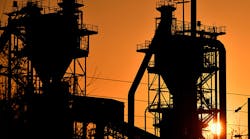Have you ever had this happen: Business is booming, capital growth is underway, expectations are high, then stop—permitting.
Of the many things the Clean Air Act does, streamlined permitting is not one of them. However, the Plant-wide Applicability Limit (PAL) can simplify the process.
What’s It to You, PAL
A PAL is a 10-year renewable air permit that manages air emissions through an annual emissions cap on the facility. This contrasts with traditional air permitting, which imposes emission limits on individual pieces of equipment and components.
I like to think of the PAL as a bubble over a facility—as long as air-contaminant emissions stay below the annual cap limit, then the facility can install, modify and move equipment as it sees fit without first obtaining a federal New Source Review permit or going through additional review.
The bubble approach speeds the capital improvement process, allowing products to get to market faster and creating a competitive advantage.
PAL permitting was developed by the U.S. EPA in the early 2000s; however, few facilities take advantage of it. Yet PALs are very attractive to manufacturing companies experiencing capital growth.
Creating a PAL
PAL permits create the greatest advantage to manufacturing facilities subject to Clean Air Act requirements, emissions oversight, and governmental controls. PAL permits are particularly attractive for facilities with emissions of Volatile Organic Compounds (VOCs) and/or Nitrogen Oxides (NOx) at or above 100 tons per year.
Obtaining a PAL permit is a four-step process:
Step 1: Establishing the PAL Emission Cap
The PAL emission cap is based on a 10-year “look back” period of baseline actual emission rates at the facility. Within the 10-year “look back,” a 24-month consecutive period will be identified to set the baseline annual emission rate. An increase threshold for the specific PAL pollutant is then added to the baseline annual emission rate to set the proposed PAL emission cap level.
Step 2: Engaging State Regulatory Agencies
Involve state regulatory permitting agencies early in the PAL process. States vary greatly in their experience and familiarity with PAL permit issuance. Getting everyone comfortable with the baseline emission data and proposed PAL emission cap limit before submission of the PAL permit application greatly assists the permitting process.
Step 3: Submitting the PAL Permit Application
Again, this process can vary from state to state. Some states use forms submitted on-line; other states do not use any templates. Working with an environmental attorney who is experienced with the PAL permit process makes this step quicker and more efficient.
Step 4: Public Notice and Comment Period
A PAL permit action includes both a public notice and comment period, and a review period by the U.S. Environmental Protection Agency.
Benefits
Advantages of a PAL include:
- Removing air permitting considerations from capital project planning and execution
- Providing cost and schedule certainty
- Reducing governmental oversight in production
- Aiding confidentiality of production methods and processes
- Reducing compliance costs and employee time spent on air-permitting issues
- Readily replicated at multiple facilities nationwide
What this means is that you get more predictability and consistency in your capital project process, allowing for faster product to market, which provides for a greater competitive advantage.
Jennifer Van Wie is a special counsel and an environmental business lawyer with the Chicago office of Foley & Lardner LLP, where she advises clients on state and federal environmental regulations. Prior to joining Foley & Lardner, Ms. Van Wie was an assistant attorney general with the Environmental Bureau of the Illinois Attorney General’s Office.




